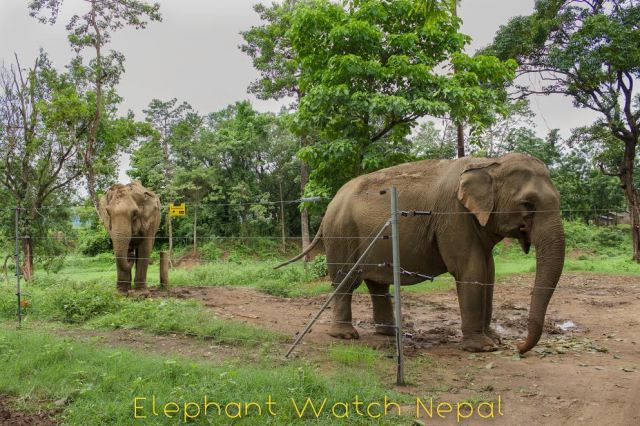Chitwan and elephant safaris seem to be synonyms. Most parents who bring their kids to to the jungle want to give them the experience of riding an elephant. So why do we oppose elephant rides? And is there an alternative? We recently visited Chitwan to find out.
It is early morning and we are moving through the jungle. We are far away from the busy touristy town of Sauraha (also known as Little Thamel). The luscious green buffer zone is filled with the sounds of birds and some barking deer. We are about to spot a male rhino, who is taking a bath in a mud pool close to the river.
Contrary to what you might think we are not riding an elephant. Instead we follow two elephants on their grazing trip through the jungle, on foot. The animals are clearly happy to move through the thick forest at their own pace. They chose their favorite plants along the way and clean them up by snapping them against their legs before munching on them. During our 90-minute walk we notice how the elephants use their trunks to touch each other’s ears as a sign of reassurance, and hear them make different sounds to communicate with one another.
Later in the day, we join the elephant bath at the Narayani River. Again, not by sitting on top of them, or scrubbing them, but simply by watching them have fun, pushing each other playfully, emerging and reemerging from the water. It is the highlight of the day, not only for the elephants, but also for us, deeply impressed by the joyful nature of these majestic animals.
We are in fact at Tiger Tops Elephant Camp, Nepal’s oldest safari company, and the first to introduce ‘non contact elephant tourism’. We get a chance witness to the incredible change the move has brought to the lives of Tiger Tops’ twelve elephants.
At this resort, elephants are no longer chained. Huge green spacious areas were built especially for them, so that they have enough room to roam around freely, play in the mud, socialize, and even cool down under the natural shade provided by the various trees in their area. From the viewing deck we observe them grazing, frolicking, and sleeping. We see first hand how the elephants’ health has greatly improved, and how they have formed intimate bonds with the elephants they are paired with.
Watch this great video by Nepali Times about the place:
The bad deal
Why do we believe non contact tourism is the only ethical approach to elephant tourism? As a start, as you probably know, captive elephants are taken from the wild and tamed in a very cruel way through the “phajaan” ritual. This training is also known as the “crush” and it consists of separating young elephants from their mothers (as early as the age of one) and then using fire to intimidate them, bull-hooks and sticks to beat them, and food and sleep deprivation to exhaust them, until they finally give up. These practices of course are not shown to tourists. The working elephants you see in Chitwan and Bardia have all already been trained that way.
When visiting Chitwan, many of us won’t notice the wounds on their feet or the scars on their foreheads. It is likely that most of us won’t know that the elephants will be kept away in corrals where they will be chained every night, standing in their dung and urine, for long hours until it is time to work again. Many are kept so tightly chained that they can hardly move or interact with other elephants. It is not known to many that captive elephants in Nepal have tuberculosis, despite getting medication, they are not generally allowed to take time off, which furthers their illness. The Himalayan Times reported in February 2016, that 20 elephants around Nepal were infected with the disease. This does not happen often to elephants living in the wild.
Knowing what we know now, we can make a difference in the life of these animals. Some may argue that the eco-friendly way to spot wildlife is to do it on the back of an elephant, but the truth is that these working elephants are an endangered species as well. Additionally, a study, found out that less than 10% of the resorts that offer jungle safaris in some parts of Asia promote educational activities with the treks. That is why we should reconsider our choices, because if we continue to create a demand for their services, future generations of elephants will suffer the same fate – and it is paramount to understand that these beautiful and sentient creatures do indeed suffer.
So what can you do to help? First of all, stop riding and bathing elephants. Instead use other means to explore the jungle – by walking, jeep or canoe. Stay at a resort that discourages elephant safaris and bathing with tourists. And if you do like to get close to an elephant, you can always visit one of the chain free enclosures established by Nepal Nature Conservation Trust at Sauraha.
There is a more ethical way to interact with elephants that feels right, both to the elephants and to ourselves.





A great and very interesting article keep up the good work!!
LikeLike
Pingback: An Open Letter to President Bidya Devi Bhandari… | Elephant Watch Nepal (EWN)
Pingback: Elephant festival of Nepal condemn by right groups – South Asia Time